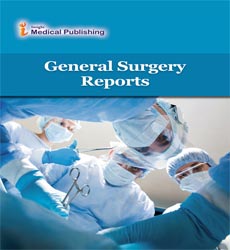Advancements in Minimally Invasive Surgery: Case Studies and Clinical Insights
*Corresponding author:
Adli Bharat,
Department of Public Health and Infectious Diseases, Sapienza University of Rome, 00185 Rome, Italy,
E-mail: Adli.bharat@uniroma1.it
Received date: February 03, 2025, Manuscript No. ipgsr-25-20673; Editor assigned date: February 05, 2025, PreQC No. ipgsr-25-20673 (PQ); Reviewed date: February 10, 2025, QC No. ipgsr-25-20673; Revised date: February 17, 2025, Manuscript No. ipgsr-25-20673 (R); Published date: February 24, 2025
Citation: Bharat A (2025) Advancements in Minimally Invasive Surgery: Case Studies and Clinical Insights. Gen Surg Rep Vol. 09.1:172.
Introduction
Minimally Invasive Surgery (MIS) has transformed the landscape of surgical practice over the last few decades, offering alternatives to traditional open procedures that minimize tissue trauma, reduce postoperative pain and accelerate patient recovery. The advent of laparoscopic techniques, endoscopic interventions and robotic-assisted platforms has expanded the range of conditions amenable to minimally invasive approaches, encompassing general surgery, gynecology, urology, orthopedics and cardiothoracic procedures. The shift toward MIS reflects a growing emphasis on patient-centered care, improved clinical outcomes and enhanced cosmetic results. The adoption of minimally invasive techniques is underpinned by technological advancements, including high-definition imaging systems, sophisticated instrumentation and computer-assisted platforms. These innovations allow surgeons to perform complex procedures through smaller incisions with precision and accuracy, often surpassing the capabilities of conventional open surgery. In addition, MIS facilitates better visualization of anatomical structures, reduced intraoperative bleeding and shorter hospital stays. Despite these benefits, challenges remain, including a steep learning curve, high equipment costs and limited tactile feedback in certain procedures [1].
Description
One of the most significant advancements in MIS is laparoscopic surgery, which utilizes small incisions, a camera and specialized instruments to perform procedures within the abdominal cavity. Laparoscopic cholecystectomy, for instance, has become the standard of care for symptomatic gallstones due to reduced postoperative pain, shorter hospitalization and rapid return to normal activities. Case studies have demonstrated that patients undergoing laparoscopic cholecystectomy experience minimal wound complications and quicker recovery compared to open procedures. Furthermore, innovations such as Single-Incision Laparoscopic Surgery (SILS) and Natural Orifice Transluminal Endoscopic Surgery (NOTES) have further reduced surgical trauma, although these approaches require specialized expertise and careful patient selection [2].
In colorectal surgery, minimally invasive techniques have shown considerable promise in managing both benign and malignant conditions. Laparoscopic colectomy, for example, has been associated with lower postoperative morbidity, faster return of bowel function and improved quality of life. Case studies highlight that, in selected patients with early-stage colorectal cancer, laparoscopic resection achieves oncologic outcomes comparable to open surgery, including adequate lymph node retrieval and margin status. Robotic-assisted colorectal surgery offers additional precision in deep pelvic dissections, particularly in rectal cancer, where narrow anatomical spaces pose technical challenges. Clinical insights indicate that robotic platforms reduce surgeon fatigue, enhance dexterity and allow for more controlled suturing, thereby improving both procedural efficiency and patient outcomes [1].
Gynecologic surgery has also benefited from advancements in MIS. Procedures such as laparoscopic hysterectomy, myomectomy and endometriosis excision minimize blood loss, reduce postoperative pain and accelerate recovery. Case reports emphasize that patients undergoing laparoscopic myomectomy experience lower adhesion formation, shorter hospital stays and faster resumption of daily activities compared to traditional laparotomy. Robotic-assisted platforms further enhance visualization of pelvic structures, facilitate precise dissection of endometriotic lesions and improve suturing in complex reconstructive procedures. These advancements underscore the importance of integrating technological innovations with clinical expertise to achieve optimal patient outcomes.
Urologic surgery has similarly witnessed substantial benefits from minimally invasive approaches. Laparoscopic and robotic-assisted techniques for procedures such as nephrectomy, prostatectomy and pyeloplasty offer precise excision of diseased tissue while preserving surrounding structures. Case studies demonstrate reduced blood loss, lower rates of postoperative complications and improved functional outcomes in patients undergoing robotic-assisted radical prostatectomy. In particular, nerve-sparing techniques facilitated by robotic platforms have been shown to enhance postoperative continence and sexual function, illustrating the potential of MIS to improve both clinical and quality-of-life outcomes [2].
Conclusion
Minimally invasive surgery has revolutionized the field of surgery by offering techniques that reduce tissue trauma, enhance recovery and improve patient satisfaction across a wide range of clinical specialties. Advances in laparoscopic, endoscopic and robotic-assisted platforms have expanded the range of procedures that can be performed safely and effectively through minimally invasive approaches. Case studies and clinical insights demonstrate the benefits of MIS in general, colorectal, gynecologic, urologic and orthopedic surgery, including reduced postoperative pain, shorter hospital stays, faster return to function and improved long-term outcomes.
While challenges such as technical complexity, learning curves, limited tactile feedback and high equipment costs remain, careful patient selection, meticulous surgical planning and adherence to evidence-based protocols can mitigate risks. Emerging technologies, including enhanced imaging, advanced energy devices and artificial intelligence integration, continue to refine MIS techniques, expanding their applicability and improving clinical outcomes. Patient-centered care, combined with technological innovation and surgical expertise, ensures that minimally invasive surgery remains a safe, effective and transformative approach to modern surgical practice.
Acknowledgement
None.
Conflict of Interest
None.
Reference
- Hansman MF, Ryan JA Jr, Holmes JH 4th, Hogan S, Lee FT, et al. (2001) Management and long-term follow-up of hepatic cysts. Am J Surg 181: 404-410.
Google Scholar Cross Ref Indexed at
- Jian-Guo Q, Hong W, Hui J, Ji-Wei H, Prasoon P (2011) Laparoscopic fenestration vs open fenestration in patients with congenital hepatic cysts: A meta-analysis. World J Gastroenterol 17: 3359-3365.
Open Access Journals
- Aquaculture & Veterinary Science
- Chemistry & Chemical Sciences
- Clinical Sciences
- Engineering
- General Science
- Genetics & Molecular Biology
- Health Care & Nursing
- Immunology & Microbiology
- Materials Science
- Mathematics & Physics
- Medical Sciences
- Neurology & Psychiatry
- Oncology & Cancer Science
- Pharmaceutical Sciences
